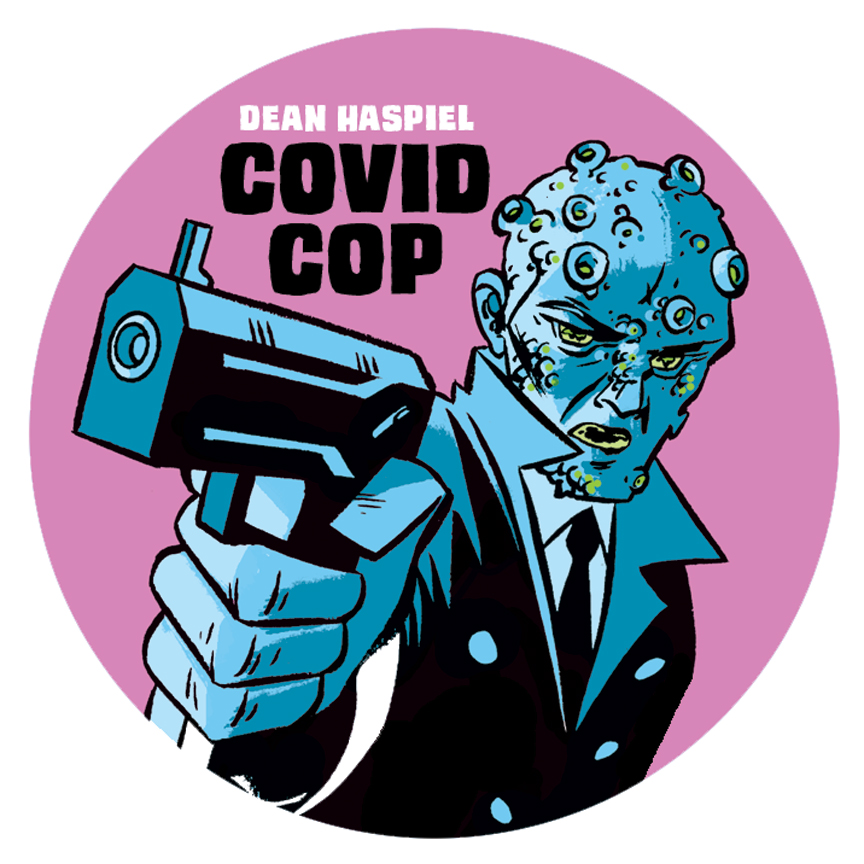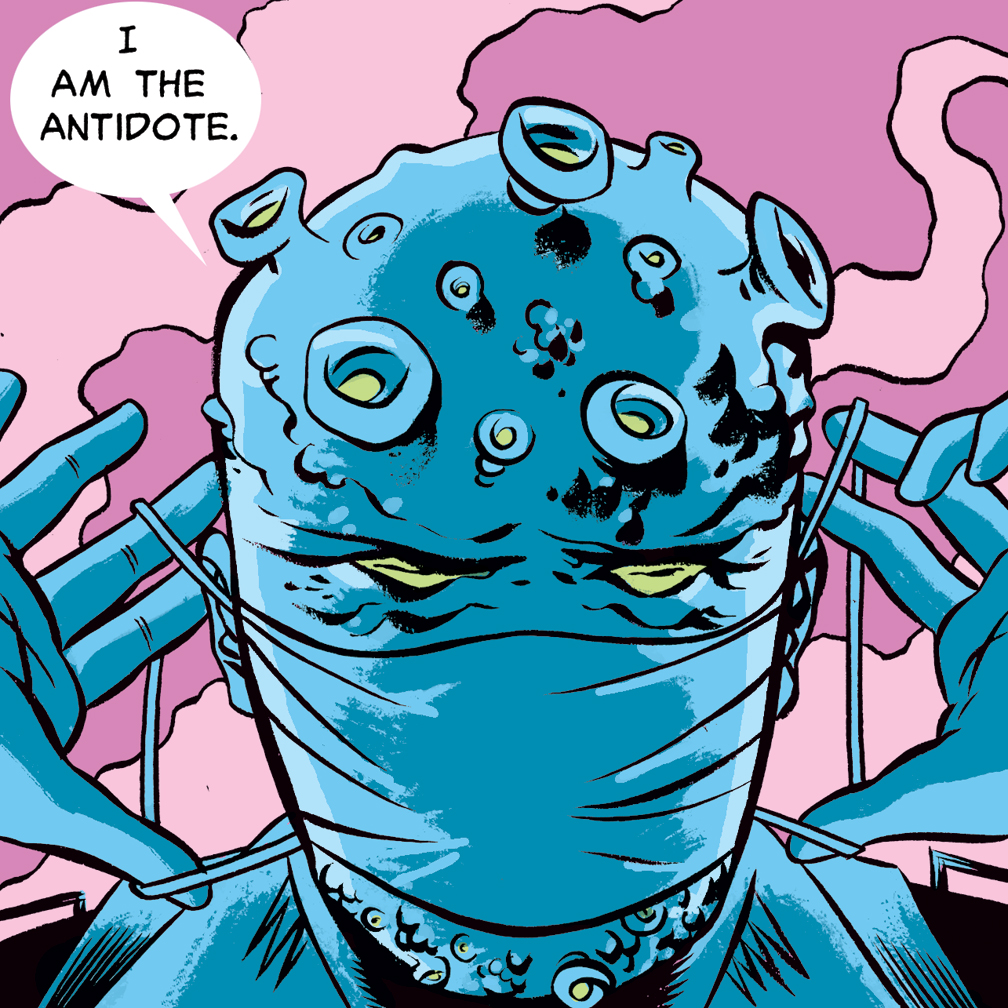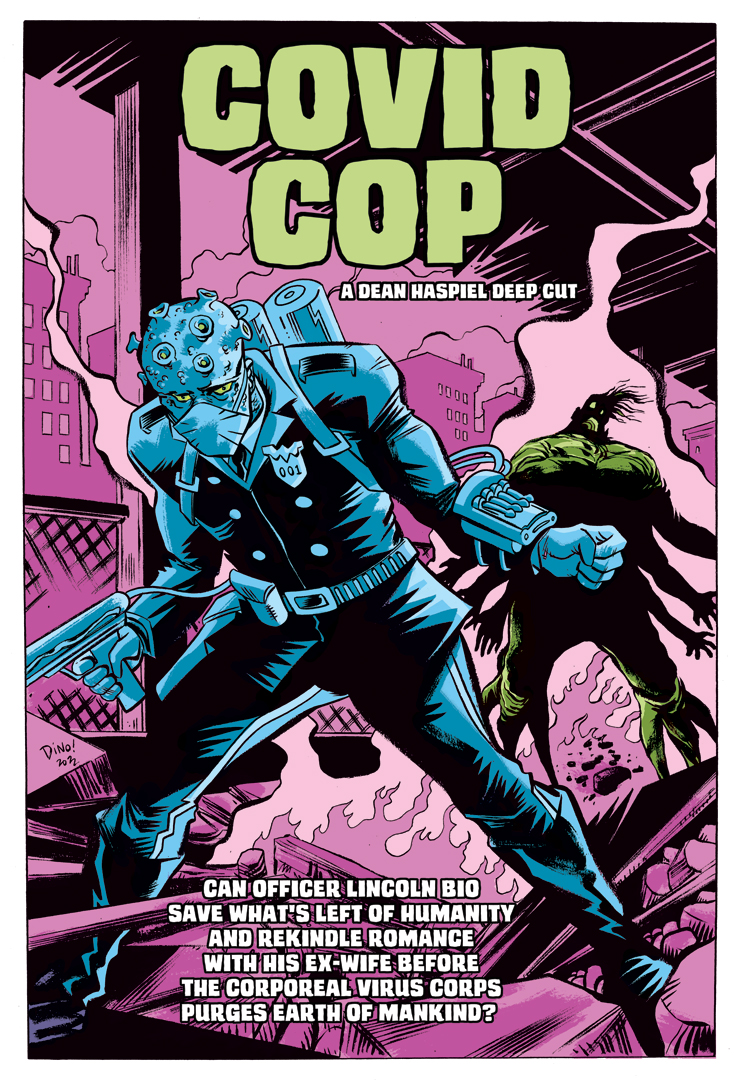OFF-TOPIC (49)
By:
March 27, 2023
Off-Topic brings you over-the-transom, on-tangent essays, dialogues and subjective scholarship on an occasional, impulsive basis. This time around, as we climb cautiously from behind the pandemic rubble, an inquest into what comes next and which traumatic imaginings we’ll be carriers of…

The walking dead pursue us through endless end-times horror dramas and reanimated ideas from a past that should stay buried plague our politics, but what you really have to worry about is the living. It’s still-all-too-alive relics of authoritarian times and rampant new viral forms that are truly spelling out our doom, and cartoonist Dean Haspiel’s Covid Cop is the delirious vision of how to put the genie back in the test tube. A side-effect of the quarantine era and an inspired relapse of classic contagion-thrillers like Omega Man, Covid Cop follows a contaminated but uncompromised protagonist as he fights to sterilize a diseased world with his hardboiled force of will. The clock is ticking, and the comic’s Kickstarter was counting down as I brought Haspiel in for some brief interrogation…
HILOBROW: The alliteration and wordplay run more rampant than ever here — associative misnomers that seem one part wacky-package to two parts oracle’s revelation, rhythmic consonance that echoes absurdist poetry and evokes a Stan Lee high-fever dream. Are we returning to Homer’s verbal theatrics, surrendering into sing-song madness, or just illustrating that history, while not repeating itself, wants to rhyme?
HASPIEL: I designed Covid Cop to satirize modern concerns while discussing man versus virus and nature versus nurture. Ultimately, it’s a horror romance that has fun with words. Something that complements yet gives alternative context to the art with my unique brand of two-fisted aggro-moxie and purple staccato. Edmund may be my middle name but it’s pronounced “bombastic.”

When I was a kid, Stan Lee was probably the first comic book writer that stood out for me. The way he took stories created by Jack Kirby and Steve Ditko, et al, and put his particular shine on them made a nearly Shakespearean difference. But it was Frank Miller, Chris Claremont, Alan Moore, Garth Ennis, Ed Brubaker and Brian K. Vaughan who put more pictures in your mind than were on the page. The person interviewing me for this article, Adam McGovern, has a provocative way with words that sometimes requires a Secret Decoder Ring that opens doors to many levels.
As I learned to read books with no pictures, I dug the writing styles of Raymond Carver, Charles Bukowski, David Mamet, Joe R. Lansdale, Richard Price, Mickey Spillane, Richard S. Prather, and Jonathan Ames. To this day I carry the first two sentences of Richard S. Prather’s Kill Me Tomorrow, a Shell Scott Mystery, in my back pocket to remind me of what words can do (for better or for worse). And I was fortunate enough to befriend and collaborate with Jonathan Ames on several projects. My Nightwork studio mate/writer, Whitney Matheson, is another fantastic wordsmith I greatly admire and am sometimes fortunate to make stories with.
I love screenplays written by William Goldman, Quentin Tarantino, the Coen Brothers, Alfred Hitchcock, Stirling Silliphant, David Milch, Martin McDonagh and many more. If I had to pick one piece of work that has influenced me more than anything else, it might just be Edward Albee’s Who’s Afraid of Virginia Woolf? A heartbreaking play that inspired me to write some of my own spectacle theater.

HILOBROW: In this book, color is chorus — the bilious greens of permanent nausea and the garish pink of iffy elixirs; the nocturnal blue that bathes all our corpse-like characters like portable midnight. We could be viewing the whole thing under a UV light bringing no good news. What part does palette play in your narrative thinking, and what visible spectrum did the pandemic bestow or hinder for you?
HASPIEL: I originally intended the black & white line art of Covid Cop to mirror the bleached chiaroscuro of Frank Miller’s Sin City but I quickly abandoned that idea when I figured out a way to let the colors do most of the atmospheric heavy lifting. Blue was the base color, honoring the complicated shades of the police and sole survivors, while purple represented the ambient hue of a ravaged Brooklyn, NY. Neon green infected its way into the toxic waters, gases and fumes, revealing the many mutations inside all of us.

HILOBROW: Binary “good” and “evil” can lob attacks from the periphery, but your stories most often focus on the intimate epicenter — where mad love is most infectious and starcrossed partners attract and repel. So it is with Lincoln Bio and Fate Majeure at COVID COP’s nucleus of interdependence v. individualism. Is it really so hard for two souls to bridge a gulf, or are these really embodiments of warring ways of seeing things within yourself?
HASPIEL: Might have something to do with the way I was raised but I’ve always been attracted to conflict. It’s not a healthy way to be, and I’m doing my best to reject drama, but it certainly makes for good stories. My fiction has always been more emotionally true than my memoir. Probably has something to do with the narrative leash which has a longer latitude. And the older I get creating my sets of Love Titans, whether it’s Billy Dogma and Jane Legit, Sam Brosia and Ava Blume (aka The Red Hook and The Possum/War Cry), or Lincoln Bio and Fate Majeure, there’s always a little bit of me in those characters. No matter how many genres I mash up and finesse into something brazen yet sentimental, it’s matters of the heart that truly connect us. If Marvel Comics purports to brandish the “unending story,” I’ve taken it a step further and ignited the oxygen that pumps our blood with flames from our souls.
MORE POSTS by ADAM McGOVERN: OFF-TOPIC (2019–2024 monthly) | textshow (2018 quarterly) | PANEL ZERO (comics-related Q&As, 2018 monthly) | THIS: (2016–2017 weekly) | PEOPLE YOU MEET IN HELL, a 5-part series about characters in McGovern’s and Paolo Leandri’s comic Nightworld | Two IDORU JONES comics by McGovern and Paolo Leandri | BOWIEOLOGY: Celebrating 50 years of Bowie | ODD ABSURDUM: How Felix invented the 21st century self | KOJAK YOUR ENTHUSIASM: FAWLTY TOWERS | KICK YOUR ENTHUSIASM: JACKIE McGEE | NERD YOUR ENTHUSIASM: JOAN SEMMEL | SWERVE YOUR ENTHUSIASM: INTRO and THE LEON SUITES | FIVE-O YOUR ENTHUSIASM: JULIA | FERB YOUR ENTHUSIASM: KIMBA THE WHITE LION | CARBONA YOUR ENTHUSIASM: WASHINGTON BULLETS | KLAATU YOU: SILENT RUNNING | CONVOY YOUR ENTHUSIASM: QUINTET | TUBE YOUR ENTHUSIASM: HIGHWAY PATROL | #SQUADGOALS: KAMANDI’S FAMILY | QUIRK YOUR ENTHUSIASM: LUCKY NUMBER | CROM YOUR ENTHUSIASM: JIREL OF JOIRY | KERN YOUR ENTHUSIASM: Data 70 | HERC YOUR ENTHUSIASM: “Freedom” | KIRK YOUR ENTHUSIASM: Captain Camelot | KIRB YOUR ENTHUSIASM: Full Fathom Five | A 5-part series on Jack Kirby’s Fourth World mythos | Reviews of Annie Nocenti’s comics Katana, Catwoman, Klarion, and Green Arrow | The curated series FANCHILD | To see all of Adam’s posts, including HiLo Hero items on Lilli Carré, Judy Garland, Wally Wood, and others: CLICK HERE
